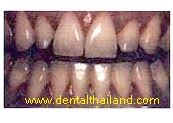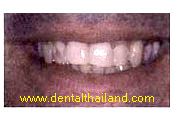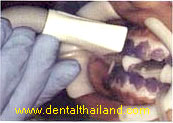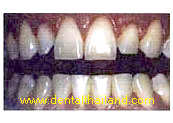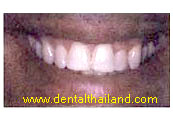| The Chemical
Reaction |
|
| Hydrogen peroxide (H2O2) breaks down to water
(H2O) and a free oxygen radical (O) The smaller, less pigmented
constituents by rapid oxidation. These compounds have double
bonds and long carbon chains that are subsequently reduced
to smaller carbon chains and hydroxyl groups, which eliminate
discoloration.
The initiation of bleaching occurs through
the application of laser which emits monochromatic light
at a specific wavelength absorbed by the catalyst molecules
only, thus accelerating the release of activated bleaching
molecules.
|
|
Hydrogen peroxide, the most accepted active ingredient for
in-office bleaching, does not decompose readily, which is
partly why current bleaching procedures require lengthy visits.
The“Truly” Laser tooth whitening has developed a Laser Gel
that, when combined with hydrogen peroxide, becomes a solution
responsive to specific laser wavelengths resulting in a rapid
production of free oxygen radicals. |
| Differentiate
Between Laser and Non-Laser Tooth Whitening
| Laser |
| The laser wavelength output is synchronized
to the proprietary whitening gel, which increases efficiency
and minimizes the amount of energy required to produce
maximum whitening. This results in shortened treatment
time and increases effectiveness while eliminating the
heating of teeth that can result in post-operative sensitivity |
| Non-Laser |
| Ordinary non-laser whitening systems
require longer treatment times and higher energy output
because of their inefficiencies. Non-laser whitening
devices use just a tiny percentage of the polychromatic
light's energy. The rest of the energy is wasted as
heat and light, which is absorbed by the teeth and adjacent
tissues, which often results in intra-operative and
post-operative sensitivity. |
Etiology
Type of Discoloration
Stains Mild Tetracycline stains
Discoloration Caused by tobacco, coffee, tea or highly colored
food
Yellowing Natural aging
Factors & Causes
Tooth color is in most cases an inherited trait,
however, tooth color mainly depends upon the condition of
the teeth, dental health and lifestyle.
Various factors could lead to tooth darkening or discoloration.
The most common factor are : the intake of staining fluids,
such as cola, tea, coffee or wine; tobacco; cigarette smoking
and time.
Change in temperature of foods and drinks allow the teeth
to expand and contract, thus enabling the penetration of stains
onto the teeth.
Foods that are slightly acidic open up the pores of the enamel
and allow stains to move in. Teeth darken as we age because
the staining factors act upon the teeth for a longer period
of time.
There are also internal causes such as tetracycline stains,
fluorosis, injury, dental work and, of course, the aging process.
Depending upon the severity of staining, bleaching will lighten
the darkest areas but may not totally remedy the condition.
Advantages of Diode Laser Tooth Whitening
*
Dramatic results in less than one hour
*
whitening the stained enamel surface without overheating the
teeth
*
No damage to the pulp
*
No side effects
*
No anesthesia required
*
Long term effect
*
Proven results over all other methods
*
pain-free treatment |
Questions & answers
| Q
: |
What causes
discolored teeth? |
| A
: |
There are many causes of tooth discoloration
such as hereditary factors, external causes, such as
consumption of staining substances, or internal causes
such as trauma, fluorosis and tetracycline discoloration. |
| Q
: |
Is the
process safe? |
| A
: |
Yes, laser tooth whitening with LaserSmileTM
is the safest procedure today. It was approved by FDA,
USA many years ago. It does not heat the tooth thus
no harm is done to the pulp. Our LaserSmileTM system
has been specifically developed and tested to ensure
that no harm is done to either enamel or dentine and
that the PH level is neutral and will not produce any
acidic effect associated with some other whitening products. |
| Q
: |
Will the
procedure hurt? |
| A
: |
In general, this is a very simple procedure
where no anesthesia is needed as no pain is experienced.
However, several patients may experience minor sensitivity
during or following the procedure. This sensitivity
lasts no more than the first 24 hours and it can be
resolved by taking an analgesic. |
| Q
: |
Is the
treatment suitable for everyone? |
| A
: |
Basically LaserSmileTM is suitable
for anyone who wishes to lighten his/her tooth color.
Nevertheless, prior to the treatment, a dental examination
will determine whether or not there is any condition
that might prevent the treatment from working as it
should. In such an event the dentist will recommend
to undergo the relevant procedure before beginning the
tooth whitening treatment. |
| Q
: |
How white
will teeth get? |
| A
: |
Up until today tooth whitening with
LaserSmileTM system have achieved better results than
any other procedure effected with halogen lamps, heat
lamps, argon and CO2 lasers. However, during consultation
the dentist will go over the patient's personal expectations
and individual clinical situation in order to achieve
the optimum natural whiteness. |
| Q
: |
How long
will the process take? |
| A
: |
The whitening process with LaserSmileTM
will take only 45-60 minutes. |
| Q
: |
How long
will the teeth remain white? |
| A
: |
The long-term effect of the treatment
varies from one person to another. Clearly, Certain
habits such as smoking, drinking coffee, tea and wine,
or neglect of regular cleansing could once again quicken
the darkening process of the teeth.
Assuming regular care is provided (including dental
check-ups), teeth can remain white for as long as 1-3
years. |
Laser
Teeth Whitening
Recent independent clinical studies showed average whitening
results of 9 shades*
24 minutes of total treatment time vs. 60 minutes for leading
non-laser systems — just four minutes of actual laser activation
LaserSmile Whitening Gel maximizes whitening effectiveness
through advanced chemistry and laser-activated chromophores
Better Return On Investment due to shorter chair time and
low per-patient kit costs
* The Journal of Cosmetic Dentistry VOLUME 19: Number 2: 70-73
|
|
One Visit ,In-Office Laser Teeth Whitening
by Bangkok Smile Dental Clinic
|
| |
Figure
1. Teeth
are isolated for the The“Truly” Laser
tooth whitening procedure
|
|
| |
| Figure
3. Proper
application of paint on dental dam and
The“Truly” Laser tooth whitening gel.
|
|
| |
| Figure
5. Unretouched
clinical photograph of a 27-year-old
male patient who presented with shade
C1 on the upper arch, and A3.5 on the
lower arch. |
|
| |
| Figure
7. Unretouched
clinical photograph of a 49-year-old
male patient. He presented with upper
arch shade A3. |
|
|
| |
| Figure
2. After
proper isolation of the teeth, the The“Truly”
Laser tooth whitening Gel is eventy
applied to the teeth surfaces. |
|
| |
Figure
4.
Laser energy is applied one quadrant
at a time.
|
|
| |
| Figure
6. Unretouched
clinical photograph of the same patient,
after treatment. Upper arch now shade
B1; lower arch now A1. |
|
| |
| Figure
8. Unretouched
clinical photograph of the same patient
after treatment. Upper arch is now B1. |
|
|
|
|






